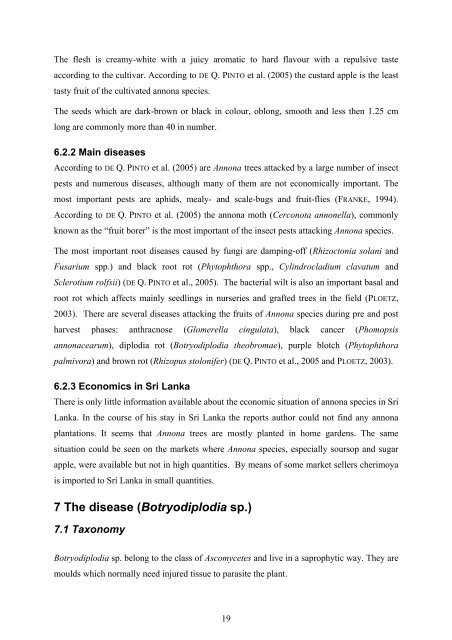Botryodiplodia sp. - Crops for the Future
Botryodiplodia sp. - Crops for the Future
Botryodiplodia sp. - Crops for the Future
You also want an ePaper? Increase the reach of your titles
YUMPU automatically turns print PDFs into web optimized ePapers that Google loves.
The flesh is creamy-white with a juicy aromatic to hard flavour with a repulsive taste<br />
according to <strong>the</strong> cultivar. According to DE Q. PINTO et al. (2005) <strong>the</strong> custard apple is <strong>the</strong> least<br />
tasty fruit of <strong>the</strong> cultivated annona <strong>sp</strong>ecies.<br />
The seeds which are dark-brown or black in colour, oblong, smooth and less <strong>the</strong>n 1.25 cm<br />
long are commonly more than 40 in number.<br />
6.2.2 Main diseases<br />
According to DE Q. PINTO et al. (2005) are Annona trees attacked by a large number of insect<br />
pests and numerous diseases, although many of <strong>the</strong>m are not economically important. The<br />
most important pests are aphids, mealy- and scale-bugs and fruit-flies (FRANKE, 1994).<br />
According to DE Q. PINTO et al. (2005) <strong>the</strong> annona moth (Cerconota annonella), commonly<br />
known as <strong>the</strong> “fruit borer” is <strong>the</strong> most important of <strong>the</strong> insect pests attacking Annona <strong>sp</strong>ecies.<br />
The most important root diseases caused by fungi are damping-off (Rhizoctonia solani and<br />
Fusarium <strong>sp</strong>p.) and black root rot (Phytophthora <strong>sp</strong>p., Cylindrocladium clavatum and<br />
Sclerotium rolfsii) (DE Q. PINTO et al., 2005). The bacterial wilt is also an important basal and<br />
root rot which affects mainly seedlings in nurseries and grafted trees in <strong>the</strong> field (PLOETZ,<br />
2003). There are several diseases attacking <strong>the</strong> fruits of Annona <strong>sp</strong>ecies during pre and post<br />
harvest phases: anthracnose (Glomerella cingulata), black cancer (Phomopsis<br />
annonacearum), diplodia rot (<strong>Botryodiplodia</strong> <strong>the</strong>obromae), purple blotch (Phytophthora<br />
palmivora) and brown rot (Rhizopus stolonifer) (DE Q. PINTO et al., 2005 and PLOETZ, 2003).<br />
6.2.3 Economics in Sri Lanka<br />
There is only little in<strong>for</strong>mation available about <strong>the</strong> economic situation of annona <strong>sp</strong>ecies in Sri<br />
Lanka. In <strong>the</strong> course of his stay in Sri Lanka <strong>the</strong> reports author could not find any annona<br />
plantations. It seems that Annona trees are mostly planted in home gardens. The same<br />
situation could be seen on <strong>the</strong> markets where Annona <strong>sp</strong>ecies, e<strong>sp</strong>ecially soursop and sugar<br />
apple, were available but not in high quantities. By means of some market sellers cherimoya<br />
is imported to Sri Lanka in small quantities.<br />
7 The disease (<strong>Botryodiplodia</strong> <strong>sp</strong>.)<br />
7.1 Taxonomy<br />
<strong>Botryodiplodia</strong> <strong>sp</strong>. belong to <strong>the</strong> class of Ascomycetes and live in a saprophytic way. They are<br />
moulds which normally need injured tissue to parasite <strong>the</strong> plant.<br />
19

















